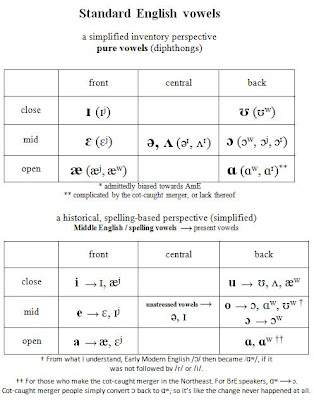

The vowels of manning and Manning, distinguished in some parts of the United States (see /æ/ raising).The vowels of bad and lad, distinguished in many parts of Australia.Both of them are transcribed as /ɔː/ or /ɔːr/, depending on the word. The vowels of pause and paws, distinguished in Cockney and by some Estuary English speakers.The vowels of north and force, distinguished in Scottish English, Irish English and by a minority of American speakers.

The difference between the vowels of fir, fur and fern, maintained in some Scottish and Irish English but lost elsewhere.Both of them are transcribed as /ɪ/ in stressed syllables and as /ɪ/ or /ə/ in unstressed syllables. The vowels of kit and bit, distinguished in South Africa.On the other hand, there are some distinctions which you might make but which this key does not encode, as they are seldom reflected in the dictionaries used as sources for Wikipedia articles: For most people from England and for some New Yorkers, the /r/ in /jɔːrk/ is not pronounced for most people from the United States, including some New Yorkers, the /j/ in /njuː/ is not pronounced and may be ignored. For example, New York is transcribed /njuː ˈjɔːrk/. In other dialects, /j/ ( yes) cannot occur after /t, d, n/, etc., within the same syllable if you speak such a dialect, then ignore the /j/ in transcriptions such as new /njuː/.In many dialects, /r/ occurs only before a vowel if you speak such a dialect, simply ignore /r/ in the pronunciation guides where you would not pronounce it, as in cart /kɑːrt/.See English-language vowel changes before historic /l/ for more information. fill /ˈfɪl/ and feel /ˈfiːl/ or pull /ˈpʊl/ and pool /ˈpuːl/ may not be distinguished. Depending on the dialect, vowels can be subject to various mergers before /l/, so that e.g.If you speak such a dialect, ignore the difference between the symbols /ʌ/ and /ə/. In Welsh English and some other dialects, the vowels of unorthodoxy /ʌnˈɔːrθədɒksi/ and an orthodoxy /ən ˈɔːrθədɒksi/ are not distinguished.If you are from Northern England, ignore the difference between the symbols /ʊ/ and /ʌ/. In Northern England English, the vowels of foot /ˈfʊt/ and strut /ˈstrʌt/ are not distinguished.If you speak either of those dialects, ignore the difference between the symbols /ʊ/ and /uː/. In Scottish English and Ulster English, the vowels of foot /ˈfʊt/ and goose /ˈɡuːs/ are not distinguished.If you speak such a dialect, ignore the difference between the symbols /ɪər/ and /ɛər/. In contemporary New Zealand English and some other dialects, the vowels of near /ˈnɪər/ and square /ˈskwɛər/ are not distinguished.If you are from New Zealand, ignore the difference between the symbols /ɪ/ and /ə/. In New Zealand English, the vowels of kit /ˈkɪt/ and foc us /ˈfoʊkəs/ have the same schwa-like quality.If you speak such a dialect, ignore the difference between the symbols /ɛər/ and /ɜːr/. Some speakers from Northern England do not distinguish the vowel of square /ˈskwɛər/ and nurse /ˈnɜːrs/.You may simply ignore the difference between the symbols /ɒ/ and /ɔː/, just as you ignore the distinction between the written vowels o and au when pronouncing them. Many speakers of American and Canadian English pronounce cot /ˈkɒt/ and caught /ˈkɔːt/ the same.Therefore, not all of the distinctions shown here are relevant to a particular dialect: This key represents diaphonemes, abstractions of speech sounds that accommodate General American, Received Pronunciation (RP) and to a large extent also Australian, Canadian, Irish (including Ulster), New Zealand, Scottish, South African and Welsh pronunciations. N URSE, w ord, g irl, f ern, f urry, B erlin, Ernesto Įdition, rabb it, Lat in, heat ing N ORTH, F ORCE, h orse, h oarse, aural ī oor, m oor, t ourist, C URE ( /ˈkjʊər/) SQU ARE, m are, sc arce, c airn, M ary įL EECE, s eed, m ean, pedigr ee, id ea For help converting spelling to pronunciation, see English orthography § Spelling-to-sound correspondences. For a table listing all spellings of the sounds on this page, see English orthography § Sound-to-spelling correspondences. If there is an IPA symbol you are looking for that you do not see here, see Help:IPA, which is a more complete list.


 0 kommentar(er)
0 kommentar(er)
